#agnatha
Text

Pacific Lamprey Conservation
After hiding under the substrate at a fish research center for nearly 7 years as larvae, Pacific lamprey EMERGED as juveniles with eyes and a suction disk mouth!
These fish, which are of Tribal and ecological importance, are now ready for their journey out to sea!
The Abernathy Fish Technology Center in Washington worked in collaboration with the Yakama Nation, the Confederated Tribes of the Umatilla Indian Reservation and the Chelan County Public Utility District to conduct this research to further understand and conserve Pacific lamprey.
This is a rare accomplishment to have Pacific lamprey reared and transformed in a captive setting.
USFWS photo: Amanda Sheehy
via: USFWS Columbia Pacific Northwest
#lamprey#ichthyology#fish#agnatha#nature#conservation#ocean#rivers#aquatic#PNW#north america#science#environment
642 notes
·
View notes
Text

Lamprey pins are back!
149 notes
·
View notes
Text
Wet Beast Wednesday: lampreys
Welcome to the first Wet Beast Wednesday covering an agnathan. What is that, you may ask? Why it means jawless fish. But they aren't really fish even though they live underwater and have gills. Taxonomy strikes again. Anyway, agnathans are more closely related to each other than to any bony or cartilaginous fish and they may represent an early stage in the evolution of vertebrates. There are only two living groups of agnathans: the hagfish (which I'll get to sometime) and the lampreys.

(Image: a pair of lampreys, one resting on rocky sediment and one swimming. They are long, green, slender fish-like animals with only dorsal and tail fins, several holes on the sides of the heads, large eyes, and no visible jaws. End ID)
Lampreys are sometimes mistakenly called eels due to their long and slender bodies. All 38 known species are elongated, scaleless animals with a funnel-shaped, jawless mouth called the buccal tunnel or buccal cavity. They do not have paired fins, only two dorsal fins and a tail fin. The head has one nostril on the top and seven pores on each side that allow water flowing over the gills to exit the body, similar to the gill slits of sharks. Adult lampreys have well-developed eyes while the larvae have weak eyes covered with skin. In addition, they have two simple parietal eyes, making lampreys the only four-eyes vertebrates. The mouth acts like a suction cup and is used to suction onto rocks or other animals. Inside the mouth is a rasping tongue that is used to scrape at food. You may think that all lampreys are parasites that feed on blood. This isn't the case, only 18 species are predatory and some of those are thought to be exclusively scavengers. The rest of the species either feed on algae by scraping it from rocks or never eat as adults, subsisting entirely on energy stores gained as a larva. The last common ancestor of all living lampreys (which is estimated to have either lived during the Jurassic or Cretaceous periods) is believed to have fed on blood as an adult. Lampreys are believed to be part of a sister group to all jawed vertebrates and are considered the most basal (closest to the ancestral form) of all vertebrates. They have cartilaginous skeletons and primitive, cartilaginous structures called arcualia instead of vertebrae. Lampreys are some of the most efficient swimmers and swim using a different method to other fish. Instead of using their fins to push themselves forward, lampreys use their fins to generate low-pressure zones in the water around their bodies to pull themselves forward. The pressure equalizing is what does most of the work of moving the lamprey, allowing them to move while expending little energy. In shallow water, the lampreys can use their suctioning abilities to crawl forward and are able to crawl over obstacles like rocks or ramps. Most lampreys are exclusively freshwater dwellers, but 9 species (all of which are carnivorous) live mostly in saltwater (though they can also live in large bodies of freshwater like lakes) and return to freshwater to breed. Of the 38 species of lamprey, only 5 species (in two families) live in the southern hemisphere. The remaining species are all members of the family Petromyzontidae and live in the northern hemisphere. No species lives in the tropics, seemingly because their larvae are not heat-tolerant.

(Image: a lamprey's mouth seen from below. It round and conical and ringed with multiple rows of sharp, yellow teeth. End ID)
The lamprey life cycle of lampreys starts in streams which adults will often migrate to reach. Adults will create nests called redds by using their suction to move rocks and expose the sediment below. Males use pheromones to attract females and the two intertwine with each other. The male presses a patch of heat-producing tissue to stimulate the female to release her eggs. The male fertilizes the eggs as they emerge. All lamprey species are semelparous, meaning they die after mating. In the case of lampreys that don't eat as adults, their adult forms exist only to mate and die, much like mayflies and some species of moth. Other species that can eat as adults spend up to 4 years feeding and growing before they mate. Larvae are called ammocoetes and once hatched, they are carried downstream to eventually settle on soft sediment. There, they burrow their rear halves into the sediment with their heads exposed. In this stage, they are filter feeders who need running water to bring plankton, algae, and bits of organic detritus to their mouths. Instead of the disc-like mouths of adult lampreys, ammocoete mouths are fleshy hood that enclose a sieve-like structures that filters particles out of the water. The lifestyle of ammocoetes is very similar to that of lancelets, which are extremely primitive chordates believed to represent some of the earliest stages of chordate evolution. Ammocoetes require water high in nutrients to survive as they capture only a small amount of water and therefore food. Ammocoetes are photosensitive, allowing them to change color in response to ambient light (becoming dark in the day and ale at night) and detect if they are properly buried. Depending on species, ammocoetes can grow between 10 and 20 cm (4-8 in) in length and they can spend between 1 and 10 years in this state. Metamorphosis to the adult form can last up to 4 months and lampreys do not feed during this process. Metamorphosis is synchronized between members of the same species.

(Image: three ammocoetes buried in sand with only their heads exposed. They are similar to the adults but pink, with small, barely-visible eyes, and their mouth are flexible and look like fleshy flaps. End ID)
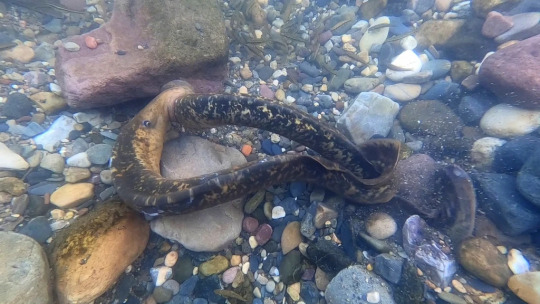
(Image: two lampreys mating. they are coiled onto each other with one using its mouth to suction onto the midsection of the other. They are on a rocky stream bed. End ID)
Lampreys are used in science for several purposes. They are often used as a model organism when attempting to understand the biology of early vertebrates and extinct agnathans. They are also studied quite a bit for their nervous systems. Lamprey brains are very simple and likely represent very early stages of brain development in vertebrates. In addition, they are useful for studies of the transmission of electrical impulses between nerve cells due to their axons (the part of a nerve cell that conducts electricity away from the main body and to other nerve cells), which are large enough for microinjectors to inject test substances into them. Lampreys are capable of fully recovering from having their spinal cords severed, something that is of great interest to surgeons and neurologists. Lampreys have been used as a food source in many cultures around the world. Some species have toxic mucus and blood, requiring them to be cleaned before eating. Historically lampreys have been kept in captivity for use in food as well as other purposes. There are records of people being executed or tortured by being thrown into a pit of carnivorous lampreys. In the wld, carnivorous lampreys generally don't attack humans unless they are starving. In addition, there is a record of one Roman statesman named Lucius Licinius Crassus being scolded for being more upset over the death of his pet lamprey than over the deaths of any of his wives. Unfortunately, the thing a lot of people know lampreys for today is the sea lamprey (Petromyzon marinus) being an invasive species in the great lakes of North America. They have no natural predators in the lakes and feed on a lot of ecologically and commercially important species. Due to their lack of predators, multiple methods are used to try to reduce their numbers and keep them from harming the ecosystem. These include using barriers to keep the adults from migrating upstream to breed, release of targeted poisons called lampricides, and releasing sterilized males into the lakes to mate with the females.

(Image: two sea lampreys suctioned onto a fish. The fish is green and covered with black dots. The two lampreys are suctioned next to each other on the top of the fish's head. Their bodies are dangling off of the fish in different directions. End ID)
#wet beast wednesday#lamprey#sea lamprey#agnatha#agnathan#jawless fish#fish#fishblr#marine biology#freshwater biology#ecology#zoology#animal facts#informative#image described
79 notes
·
View notes
Text
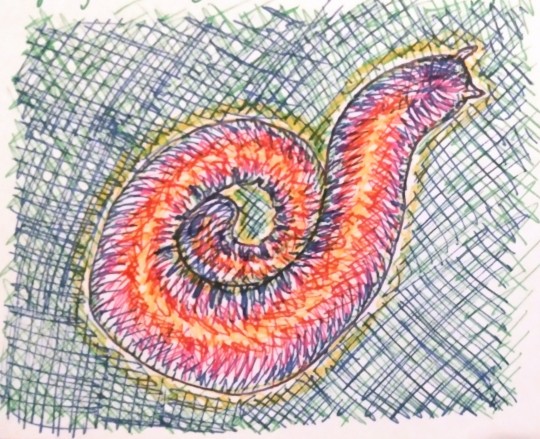
hagfish (i don't have a light blue pen)
22 notes
·
View notes
Text
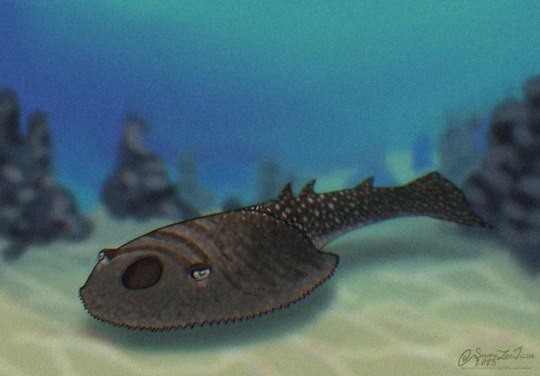
Foxaspis
Foxaspis — рід дуюнолепідних галеаспід з празького віку (девон) регіону Гуансі, Південний Китай. Типовим і єдиним видом є F. novemura, відомий за двома екземплярами. Перший складаються з повного головного щита, зчленованого з тілом і хвостом, а другий — неповного головного щита і винятково збереженого хвоста.
Повний текст на сайті "Вимерлий світ":
https://extinctworld.in.ua/foxaspis/
#foxaspis#devonian#china#galeaspida#agnatha#fish#ua#paleontology#paleoart#prehistoric#extinct#digital art#prehistory#illustration#fossils#article#sciart#art#палеоарт#палеонтологія#ukraine#ukrainian#україна#мова#арт#китай#риби#наука#українська мова#український tumblr
14 notes
·
View notes
Text

A fossilized agnathan head shield of an Ukrainaspis kozlowskii from the Dniester Formation in Nyrkov, Zalishchyky Raion, Ternopil Oblast, Ukraine. Like many similar osteostracans, this jawless fish was originally within the genus Cephalaspis. Osteostracans like Ukrainaspis are armored agnathans or jawless fish that are more closely related to lamprey and hagfish than to bony fish and chondrichthyans. These odd head shields may have been an adaptation against the rise of predatory jawed fish.
#fish#jawless fish#fossils#paleontology#palaeontology#paleo#palaeo#ukrainaspis#osteostraci#agnatha#devonian#paleozoic#prehistoric#science#paleoblr#ウクライナスピス#化石#古生物学
2 notes
·
View notes
Text
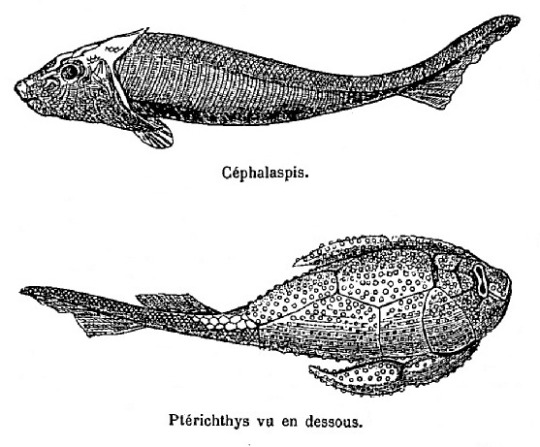
Cephalaspis and Pterichthys from L'Animaux d'Autrefois (Animals of the Past) by Victor Meunier, 1869
https://gallica.bnf.fr/ark:/12148/bpt6k206510x/f267.item
0 notes
Text
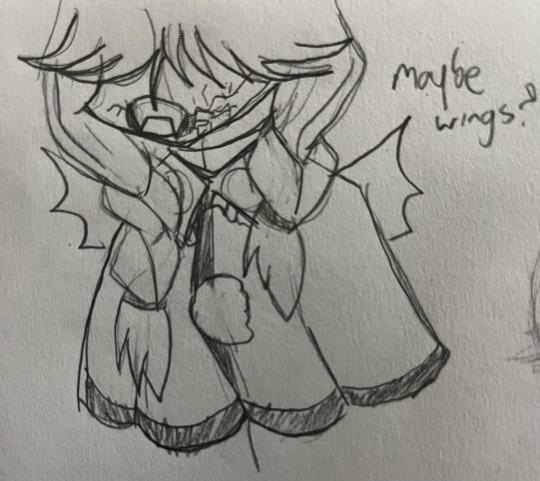
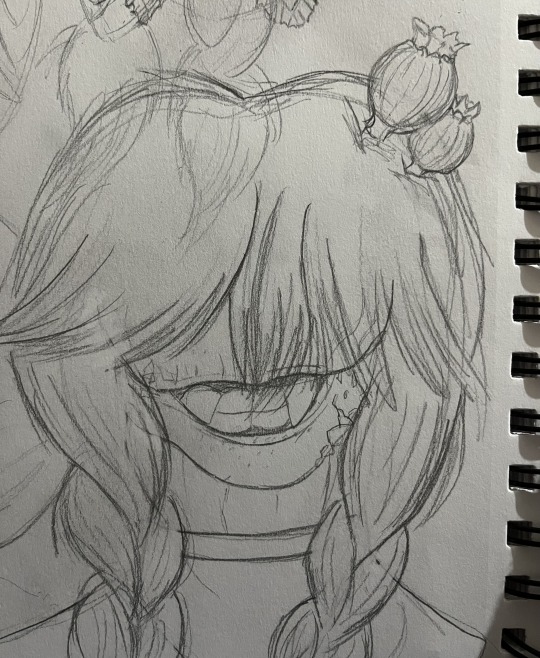
agnatha btw. theyre a gargoyle sent to assist dedan in managing zone 1, since he cant be in multiple places at once + zone 1 is responsible for the majority of exports. theyre able to turn into stone and stay mostly stationary in that state, but they are conscious - some elsen talk to agnatha while in their statue form, unaware that they can hear all of their woes and worries.
while agnatha is loyal to dedan and holds a certain affection for him, his descent into corruption pains them greatly. agnatha would prefer to cling to their memories of the past, but in the end made the decision to work with dedan to salvage what was left of their beloved zone, providing a gentle yet unyielding hand to soothe his anger.
despite making it a point not to actively oppose dedan too openly in front of others, they are still seen as a pillar of strength for the inhabitants of zone 1. agnatha tries to keep at least a facade of order, so their harsher condemnations and heated arguments are kept (mostly) between them and dedan, but the fact that agnatha isnt afraid to call him out on the way he treats people creates a sense of comfort, even if it is an unsteady and short-lived one.
#.agnatha [si]#selfship#selfship community#off oc#tagging this with fandom tag Please be niceys#i have a couple of wips of agnatha and dedan that ill finish later this week hopefully#i have more lore too lolol. they frequent the meat fountains and have a sort of complex about being a protector of the elsen#overprotective and grows into seeing Themselves as the one responsible for zone 1#but it grows into corruption as well
9 notes
·
View notes
Text

bad night
7 notes
·
View notes
Photo

These fossilized lamprey hatchlings disprove an age-old evolutionary theory
Lampreys were thought of as models of early vertebrate evolution, but new evidence suggests otherwise.
For more than a hundred years, evolutionary biologists suspected that the lamprey, a jawless, eel-shaped, blood-sucking fish, was the closest living model of the very first vertebrates.
The lamprey is one of a handful of animals that exist on the boundary between vertebrates and our invertebrate forebears.
Adult lampreys have a spinal column and swim through the water in search of fish, which they latch onto and bleed out with a tooth-filled mouth. But “the early phase of their life is entirely different and preposterous,” says Tetsuto Miyashita, a vertebrate paleontologist at the Canadian Museum of Nature.
Larval lampreys live like sea anemones, spending the first two to seven years of their lives buried in streambeds, filtering food out of the water with toothless, muscular throats. Because of that close resemblance to invertebrates, lampreys have long been treated as a model for the earliest vertebrates–not exactly our ancestors, but dopplegangers.
“Here’s a primordial-looking animal that transformed from this supposedly primitive state,” Miyashita explains. “It seemed like an analogue for what must have happened in an early stage of evolution. It’s a very convenient story.”
But research on new fossils of Paleozoic lamprey larvae, published Wednesday in the journal Nature, have turned that story upside down.
“It was very clear to me, like that morning icicle hanging off my roof right there, that we turned over a 150 year old evolutionary theory,” says Miyashita, who was a lead author on the research.
Read more: https://www.popsci.com/story/animals/lamprey-fish-evolution
#evolution#vertebrates#lamprey#agnatha#jawless fish#fish#animals#nature#science#prehistoric#fossils#ocean#aquatic#marine biology
433 notes
·
View notes
Text
Taxonomy Tournament: Chordata

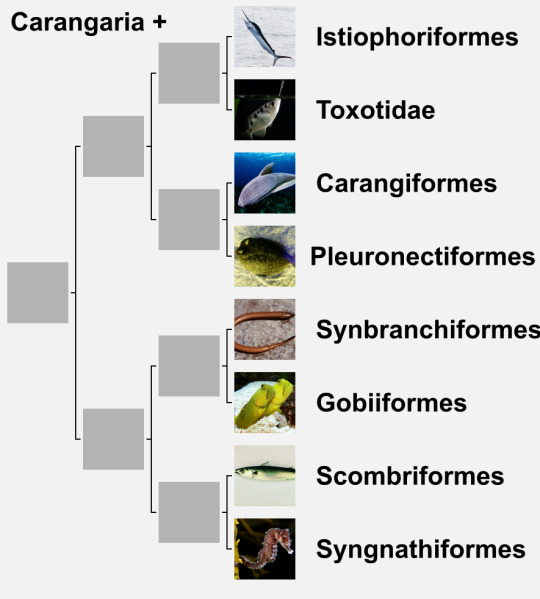
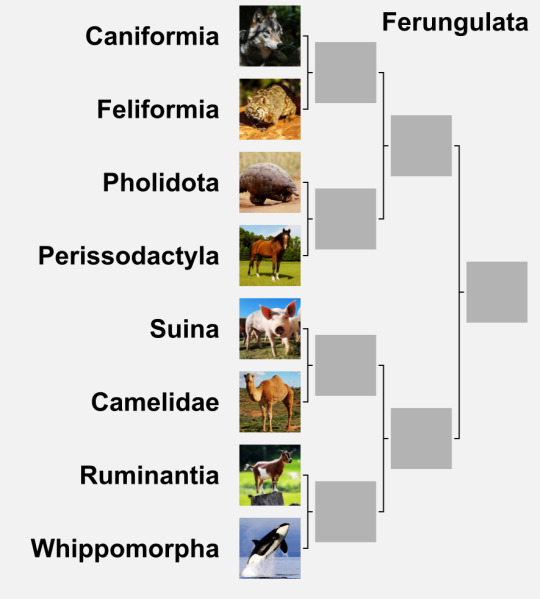
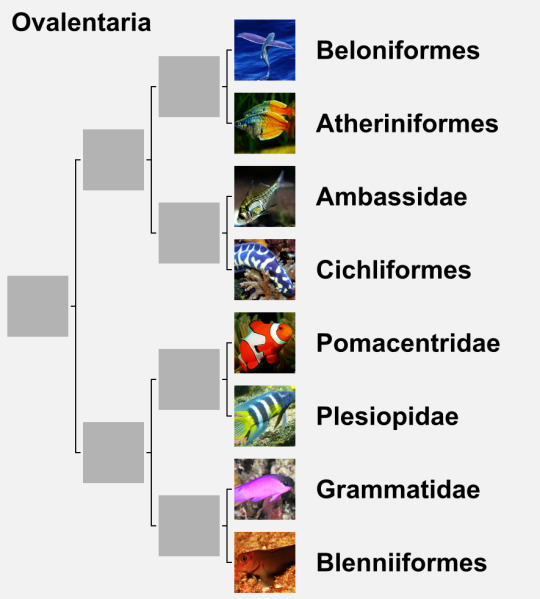

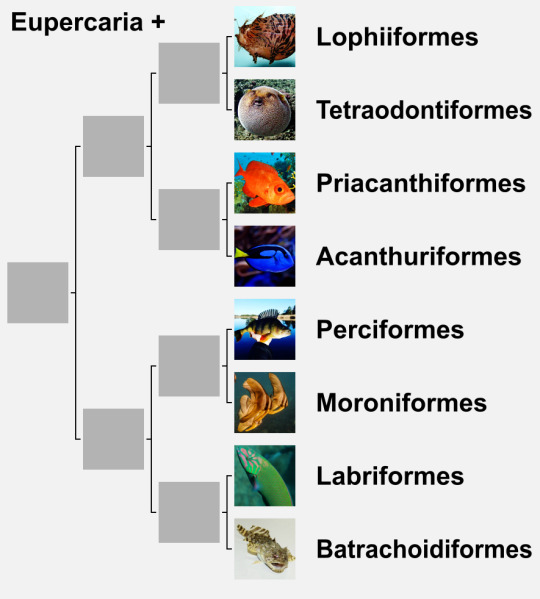



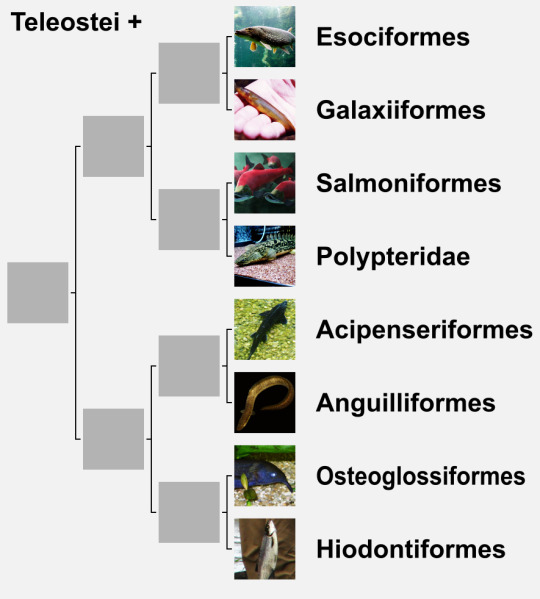







Bracket is mostly organized so that animals will compete against their closest (or at least a relatively close) relative. Top-left is mammals (+ Amphibians + lobe-finned fish). Bottom-left is reptiles (including birds). Right is fishes (including sharks and rays, + agnatha and invertibrates)
Virtually every mammal, reptile and bird is included, as are all sharks. Some fish were not included, due to space.
Looking for animals without a spine? See the other half of the bracket, the Invertibrate Bracket.
#Animal Tournament#Animal Tournament Announcements#biology#taxonomy#animal biology#marine biology#evolution#zoology#tumblr polls#tournament poll#poll tournament#bracket tournament#snakes
43 notes
·
View notes
Text

I'm pioneering something here.
Hagfishgirl named Agatha — after Agnatha the infraphylum for jawless fish: she goes by Aggie though.
She's an E-girl who sells her slime on her elite-tier patreon.
#furry#hagfish#hagfish girl#hagfish furry#fish furry#furry art#fursona#fur art#hagfish slime#aggie#agatha#jawless fish#marine biology#pacific hagfish#anthro#anthro art#furry artist#artist on tumblr#my art#e girl#bath water#cute#cute furry#there are many advantages to being a marine biologist#there are many benefits to being a marine biologist#pink#pastel#this post was too sexy for r/furry#mermaid#rare fursona
368 notes
·
View notes
Text

Pycnosteus
Pycnosteus — вимерлий рід безщелепних риб девону з підряду Psammosteida. Вперше рід описаний у 1911 р. російським палеонтологом І. Преображенським. Типовим видом роду є Pycnosteus palaeformis. Рід був поширений в середньому девоні в Естонії, Латвії, а також в Ленінградській і Псковській областях Росії. Вважається, що він продирався крізь рослинність, поїдаючи дрібних безхребетних, яких налякав.
Повний текст на сайті "Вимерлий світ":
https://extinctworld.in.ua/pycnosteus/
#pycnosteus#devonian#fish#latvia#art#estonia#psammosteida#pisces#agnatha#pycnosteus_palaeformis#paleontology#paleoart#prehistoric#animals#science#illustration#prehistory#fossils#extinct#daily#палеоарт#палеонтологія#ukraine#ukrainian#україна#мова#українська мова#арт#тварини#animal art
4 notes
·
View notes
Text
Fish Taxonomy
The term fish is commonly used to refer to members of Actinopterygii (ray-finned fish, mostly what people think of when they imagine fish)and Chondrichthyes (cartilaginous fish, the sharks, rays, etc, and chimeras). It is also used for Sarcopterygii (lobe-finned fish, the coelacanths and lungfish) and Agnatha (jawless fish, the hagfish and lampreys), although people don’t talk about lobe-finned and jawless fish as much as they do ray-finned fish and sharks. Tetrapoda (four-limbed vertebrates) is nested within Sarcopterygii, and mostly contains animals which traditionally have not been considered fish (you, me, your cat, the chicken eating your popcorn, the frog hopping away from the chicken). In modern cladistics, this is a little bit of an issue, because the common use of fish as described above is paraphyletic, i.e. it does not include all of the descendants of the group’s last common ancestor. Here are some different ways this issue can be resolved.
Option 1: Fish is not a cladistic term, and therefore we don’t need to worry about whether it’s a good and well formed clade. Reasonable and understandable, we have loads of scientific terms to unambiguously talk about groups of animals, but also boring. Play with me in this space!
Option 2: Fish includes Osteichthyes (Actinopterygii plus Sarcopterygii), Chondrichthyes, and Agnatha, therefore it is essentially synonymous with Vertebrata. You, me, and Moby Dick are all joyfully fish (Melville was right!) (and also a fish). Is this really helpful? Maybe not, but it’s fun.
Option 3: Fish is not a cladistic term, it’s a non-scientific term used to refer to any animal that lives in the water. Jellyfish are fish, starfish are fish, dolphins are fish, humans are not fish, why would you ever suggest such a silly thing?
Option 4: Fish is essentially synonymous with Vertebrata, so why not expand that to all of Chordata? Tunicata and Cephalochordata are welcomed into the Fish Club.
Option 5: Fish is a lifestyle. In the same way that a tree is any plant that gets tall and kinda woody, a fish is an obligate aquatic animal that actively swims. Salmon are fish, tadpoles are fish, frogs are not fish, sea stars are not fish, porpoises are fish, octopuses (-pi, -podes) are fish, most gastropods are not fish, but Phylliroe is absolutely a fish.
Option 6: Fish comes from the Proto-Indo-European root *peysḱ- (“fish”), which is probably derived from *peyt- (“to feed, to guard, to nourish”), and is cognate to lots of words having to do with food (Sanskrit पितु (pitu, “food”), Lithuanian piẽtūs (“lunch”), etc), so if someone asks you “is this a fish?” you must slap it on the grill, maybe squeeze some lemon on it, and find out for yourself.
38 notes
·
View notes
Note
Can anyone remind me why we dug Mildew out of the snow for two weeks after the Blizzard of Olaf if we are spending the rest of our lives wondering why we bothered and are now celebrating that he's gone?
It’s because Gothi received a vision from the gods that someone would have a change of heart, and we’d hoped it was MIildew, but it turned out to be Agnatha Who Hates Trout trying trout for the first time and liking it.
84 notes
·
View notes
